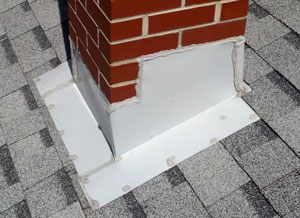Prefabricated or Manufactured Leaking Chimneys

Prefabricated chimneys or manufactured chimney systems are typically a double or triple wall pipe with air spacers or insulation in between the chimney pipe. The outter wall of the pipe can be stainless steel, Galvalume, or galvanized steel. The inner wall of the chimney is usually stainless steel. Prefabricated chimneys can be surrounded by a chase (a structure used to protect and beautify the structure of the pipe). Some pipe manufacturers require it and some don't.
Prefabricated chimneys are often subject to a different set of problem areas that can cause leakage, but do have the similar problem of flashings.
Manufactured Chimney Chase Covers
 A chase cover is the metal pan that covers the top of the chimney. Chase covers are typically made from galvanized steel, stainless steel, copper, aluminum and even vinyl. Most of these chase cover types are very durable, but galvanized steel, which is subject to rust and corrosion issues, is one of the most common types used, due to cost and availability.
A chase cover is the metal pan that covers the top of the chimney. Chase covers are typically made from galvanized steel, stainless steel, copper, aluminum and even vinyl. Most of these chase cover types are very durable, but galvanized steel, which is subject to rust and corrosion issues, is one of the most common types used, due to cost and availability.
Lack of a Storm Collar
 One of the most common issues I have seen is lack of a storm collar between the chimney pipe itself and the chase pan. The storm collar should be made from a durable metal and be properly sealed with a durable elastic sealant to prevent water from running down next to the pipe and into the house. This is important because there are difference pieces of metal running in different directions. The different pieces of metal expand and contract with temperature differences.
One of the most common issues I have seen is lack of a storm collar between the chimney pipe itself and the chase pan. The storm collar should be made from a durable metal and be properly sealed with a durable elastic sealant to prevent water from running down next to the pipe and into the house. This is important because there are difference pieces of metal running in different directions. The different pieces of metal expand and contract with temperature differences.
Maintainence on the Exterior Siding/Masonry
 Prefabricated chimneys often have a chase built around them to protect the chimney pipe. Sometimes those chases need to be maintained to provide proper leak protection. Prefabricated chimney exteriors can be made of metal, wood and cultured stone or brick. There are different maintainence items needed for each type. If it is wood siding, the seams between the the boards should be sealed with a high quality sealant. Inthe case of cultured brick and block, the brick/block and mortar joints should be checked for cracks and/or missing areas.
Prefabricated chimneys often have a chase built around them to protect the chimney pipe. Sometimes those chases need to be maintained to provide proper leak protection. Prefabricated chimney exteriors can be made of metal, wood and cultured stone or brick. There are different maintainence items needed for each type. If it is wood siding, the seams between the the boards should be sealed with a high quality sealant. Inthe case of cultured brick and block, the brick/block and mortar joints should be checked for cracks and/or missing areas.
Prefab Chimney Flashing
 Just as in brick and stone chimneys, the flashing that joins the chimney to the roof can have failed seals, be not installed properly, or have none at all. Chimney flashing is the metal that joins the roof to the chimney. It should be installed in a way that water runs down the flashing and is unable to get under the flashing, just like your roofing materials. Chimney flashings are typically made from a durable material, then often sealed with a flexible sealant such as tar, silicone, polyeurathane...etc.
Just as in brick and stone chimneys, the flashing that joins the chimney to the roof can have failed seals, be not installed properly, or have none at all. Chimney flashing is the metal that joins the roof to the chimney. It should be installed in a way that water runs down the flashing and is unable to get under the flashing, just like your roofing materials. Chimney flashings are typically made from a durable material, then often sealed with a flexible sealant such as tar, silicone, polyeurathane...etc.
